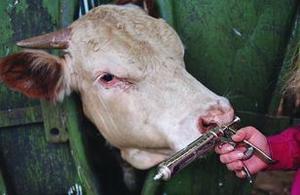SuperbugsFDA allows use of antibiotics in livestock despite “high risk” to humans
The Center for Disease Control and Prevention (CDC) has recently confirmed the link between antibiotic use on industrial farms and the rise of antibiotic resistance, saying there is “strong scientific evidence of a link between antibiotic use in food animals and antibiotic resistance in humans,” and warns of “potentially catastrophic consequences” if resistance is not slowed. The Food and Drug Administration (FDA), however, has quietly allowed thirty potentially harmful antibiotics, including eighteen rated as “high risk,” to remain on the market as additives in farm animal feed and water. The FDA first recognized the risks from the use of antibiotics in animal feed in 1977, when it proposed to withdraw approvals for animal feed containing penicillin and most tetracyclines. The agency has not followed through on its own findings – and has fought court orders to do so — and today 70 percent of all medically important antibiotics sold in the United States are sold for use in livestock production — not on humans.

An enormous percentage of antibiotics are used on livestock // Source: kenyon.edu
The Food and Drug Administration (FDA) quietly allowed thirty potentially harmful antibiotics, including eighteen rated as “high risk,” to remain on the market as additives in farm animal feed and water — despite an internal review that raised significant red flags, according to agency records obtained by the Natural Resources Defense Council (NRDC). An NRDC release reports that the data show the use of these drugs in livestock likely exposes humans to antibiotic resistant bacteria through the food supply. FDA’s scientific reviews of these antibiotics occurred between 2001 and 2010, yet the drugs remain approved and, in many cases, on the market for use in industrial animal agriculture operations.
“The evidence is clear. Drugmakers never proved safety. And FDA continues to knowingly allow the use of drugs in animal feed that likely pose a ‘high risk’ to human health. That’s a breach of their responsibility and the public trust,” said Carmen Cordova, NRDC microbiologist and lead author of the new NRDC analysis. “This discovery is disturbing but not surprising given FDA’s poor track record on dealing with this issue. It’s just more overwhelming evidence that FDA — in the face of a mounting antibiotic resistance health crisis — is turning a blind eye to industry’s misuse of these miracle drugs.”
FDA’s documents, captured in the analysis Playing Chicken with Antibiotics, show safety reviews of various drugs in the penicillin and tetracycline drug classes — antibiotics considered important to human medicine, which together comprise nearly half of all antibiotics used in animal agriculture in the United States. The documents were acquired through a Freedom of Information Act (FOIA) lawsuit filed by NRDC and reveal:
- None of the thirty antibiotics would likely be approved as new additives for livestock use if submitted under current FDA guidelines, because drugmakers have not submitted sufficient information to establish their safety.
- Eighteen of the thirty antibiotic feed additives reviewed (nearly two out of three) were deemed to pose a “high risk” of exposing humans to antibiotic resistant bacteria through the food supply and of adversely affecting human health.
- Drug manufacturers never submitted sufficient information for the remaining twelve products to establish safety, meaning there is no proof of their safety for humans when used in animal feed and the products could not be approved today.
- Twenty-nine of the reviewed additives fail to satisfy FDA’s first iteration of safety requirements from 1973.
